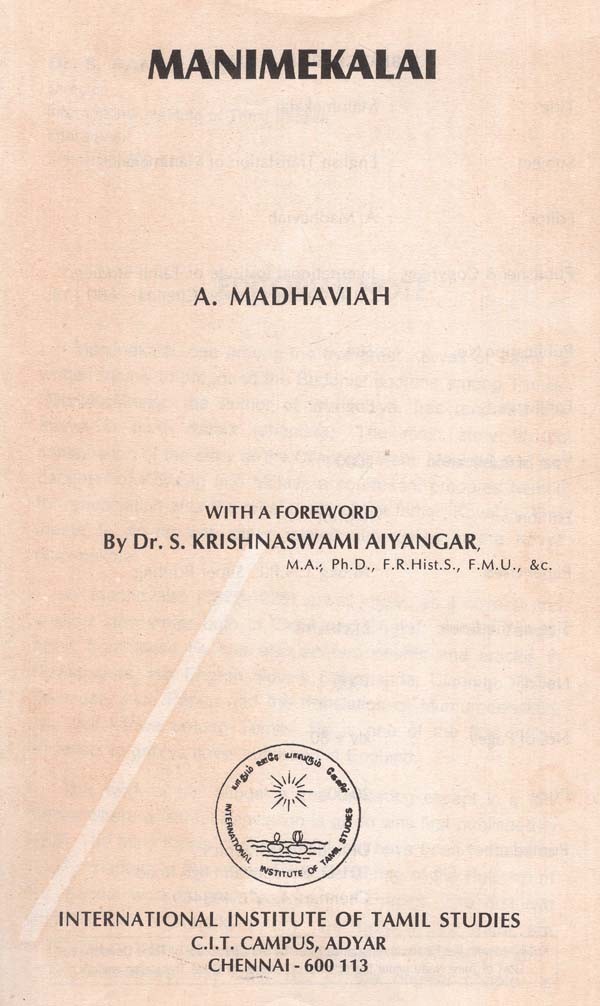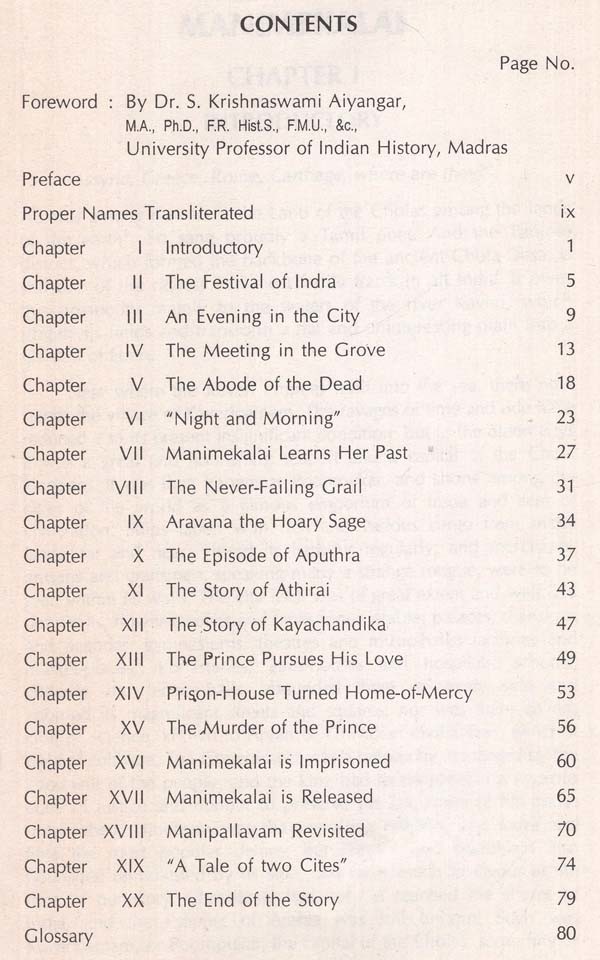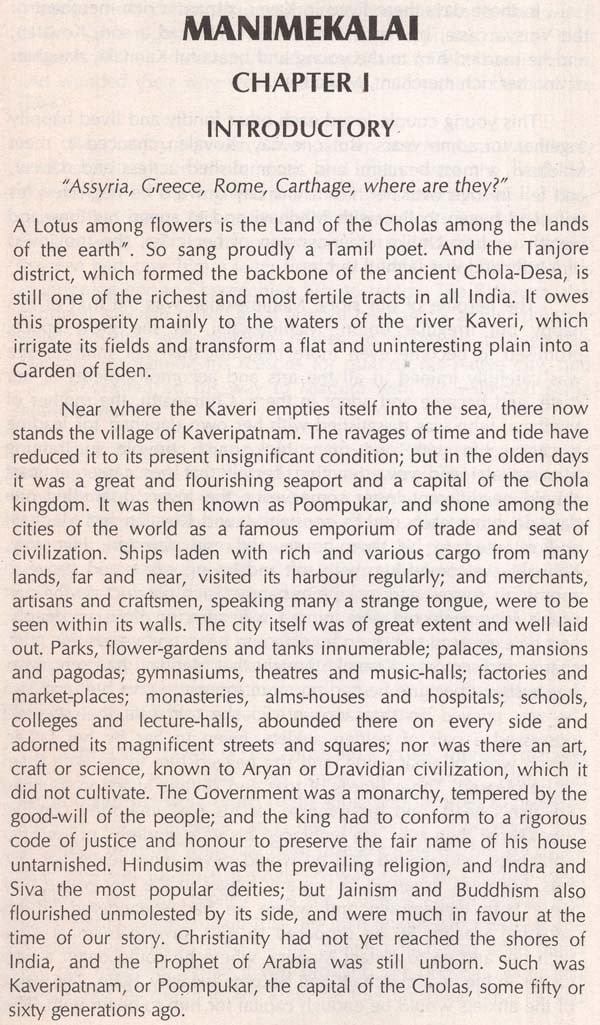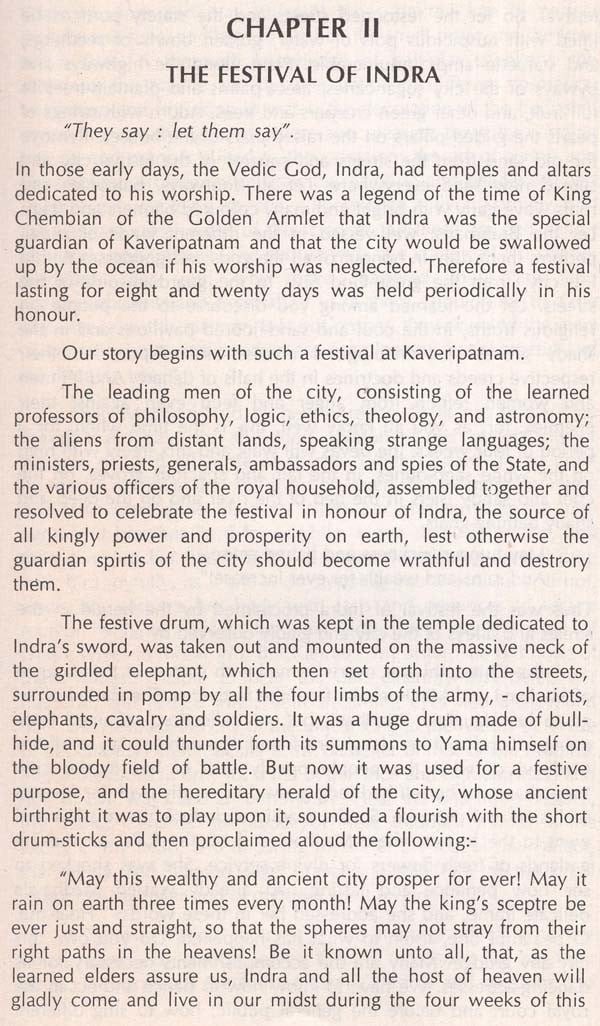
மணிமேகலை- Manimekalai (An Old and Rare Book)
Book Specification
| Item Code: | AZH610 |
| Author: | A. Madhaviah |
| Publisher: | International Institute of Tamil Studies, Chennai |
| Language: | English |
| Edition: | 2000 |
| Pages: | 94 |
| Cover: | PAPERBACK |
| Other Details | 8.50x5.50 INCHES |
| Weight | 110 gm |
Book Description
As a writer, both in English and Tamil, Mr. Madhaviah needs no introduction. Readable versions of the great classics of Tamil Literature have long been a desideratum, and all efforts to remove the want are worthy of commendation. Among the great classics of Tamil Manimekalai deservedly occupies a high place, having had its praise sung by such a discerning critic of great judgment as Sivaprakasa Swamigal. Silappadhikaram and Manimekalai constitute a twin epic and ought to go together. The authors were friends, and the stories run one into the other. The princely author of the first belonged to the royal house of Vanji, the Chera capital on the West Coast. His friend, the author of the second, was a corn merchant of Madura, the critic par excellence of the "Third Sangam". Though tradition does not in so many words declare that these works went before the Sangam and received its imprimatur, Tamil scholarship is unanimous in regarding these as "Sangam Works," properly so called. Notwithstanding much irrelevant and inconclusive writing, the age of the Third Sangam" is about the second century after Christ; no valid reason has so far been offered to the contrary.
Manimekalai is a work of a dramatic-epic character, and has for its subject-matter the renunciation of the heroine. As it treats of this subject it has necessarily to find its setting in contemporary life and thought. While it may be readily taken as a picture of Tamil life in the age of Senguttuvan, its use for purposes of history requires not merely "the insight and imagination" that Lord Morely demands, but a fully developed historic sense which could separete, by sound criticism, the historical grain lying hidden in the chaff of legend and tradition. In qualified hands it provides considerable material for the history of the age, and a few data of an important character for Tamil literary history.
Manimekalai is one of "the five great poems" in Tamil. The other four are Jivaka-Chintamani, Chilappadhikaram, Valayapathi and Kundalakesi, of which the last two are not extant. The Tamils owe a lasting debt of gratitude Pundit to Mahamahopadhyaya Swaminatha Ayyar for his scholarly editions of the remaining three works, among other classics.
Of the three "great poems" that we now have, Chilappadhikaram and Manimekalai, forming a continuous story, belong to an earlier age, while Chintamani is of a few generations later. But in their atmosphere and leanings all the three are more Buddhistic than Hindu. The noble rationalism of self-sacrifice, universal compassion and service promulgated by the great Sakya Prince must have then prevailed widely in South India, where it is now almost unknown. As for the contents of these works, they are not historical biographies of the men and women whose lives they profess to narrate, but are rather romances abounding in the supernatural and the miraculous. In saying this I do not forget that the reputed authors of the two earlier poems assure us that they were contemporaries of the events they set forth, one of them being a native of the very city where Kovalan was slain and Kannaki proved the power of her chastity by a miracle, while the other was a prince in the land where, by another miracle, she ascended to Heaven with her husband. Rather I remember how Valmiki too claims to have lived at the time of Rama and to have taken no insignificant part in the incidents of the immortal epic which bears his name. It may be that this was a form of literary convention in those days, a trick of the trade' not unknown in, other literatures or to our own age. Nor do I forget the fact that several historic personages, whose co-existence has been verified by other and more authentic records, are referred to, or made to figure, in these works. Indeed I do not assert that Kovalan and Kannaki, Manimekalai and Madhavi, never existed and are wholly fictitious, or even that they had no such careers as have been assigned to them by the authors. But I do say that not all the incidents of their lives, set forth in such minuteness of detail, could have happened, and that some of them never did take place. Chilappadhikaram differs from Manimekalai in this respect, that its main story, up to the point of Kovalan's murder by the king's guards, is quite, probable, and miracles step in only later; whereas in Manimekalai the author resorts to the supernatural almost from the beginning. Such wonders as flying through the air, remaining invisible or changing one's form at will, feeding many people out of a small bowl without replenishing its contents, and stone images speaking to human beings, are the common stock-in-trade of all romances and legends; and they prove nothing more than the faith and credulity of the times. The few true original facts, travelling from mouth to mouth, or perhaps from generation to generation, must have gathered supernatural trappings and miraculous decoration in course of time. Around such a doubtful nucleus the poet's imagination has bodied forth the forms of things unknown, andhis iron style, screeching on palm leaves, has given to aëry nothings local habitations and names.
**Contents and Sample Pages**











